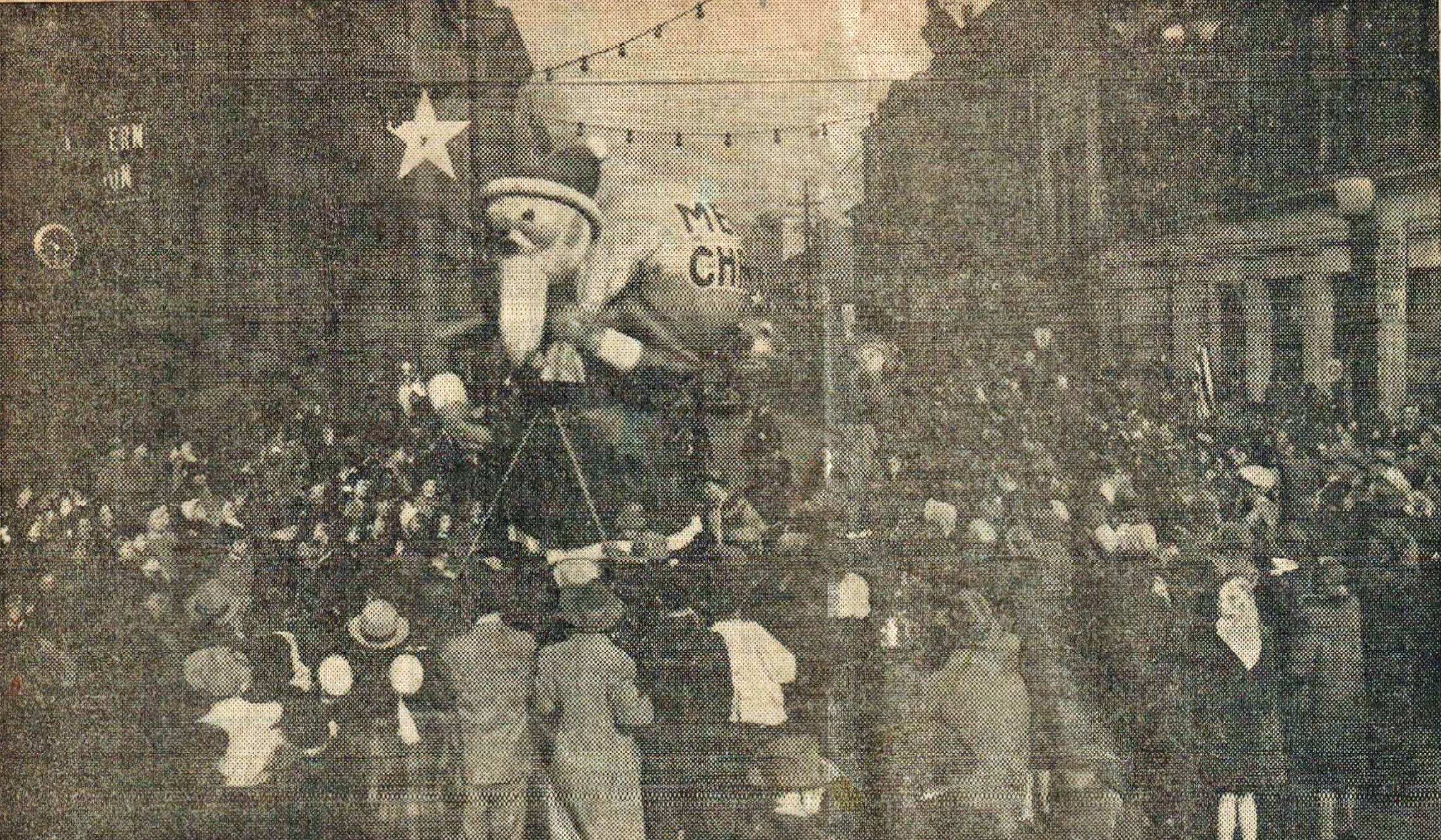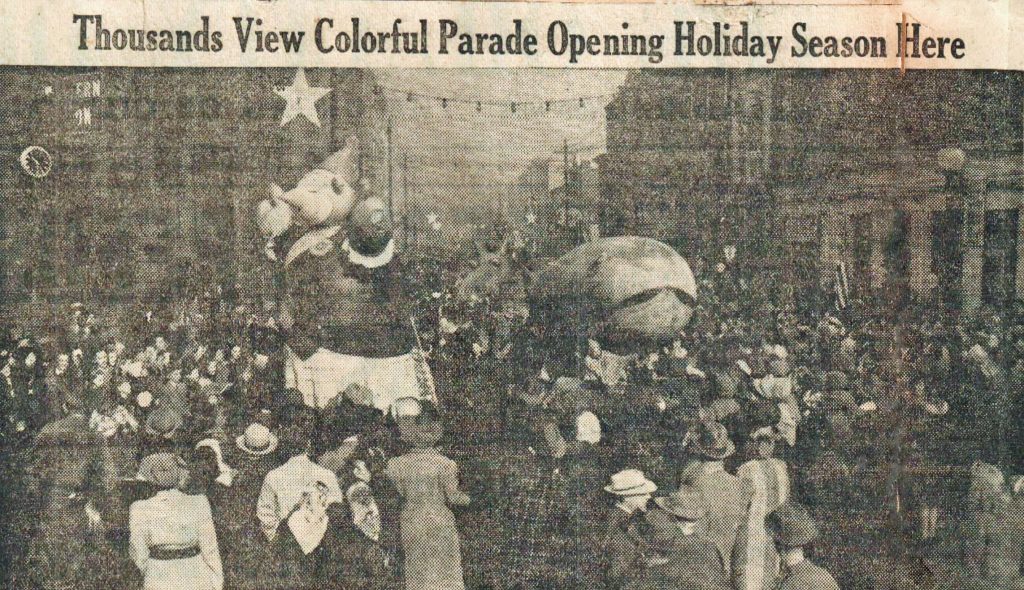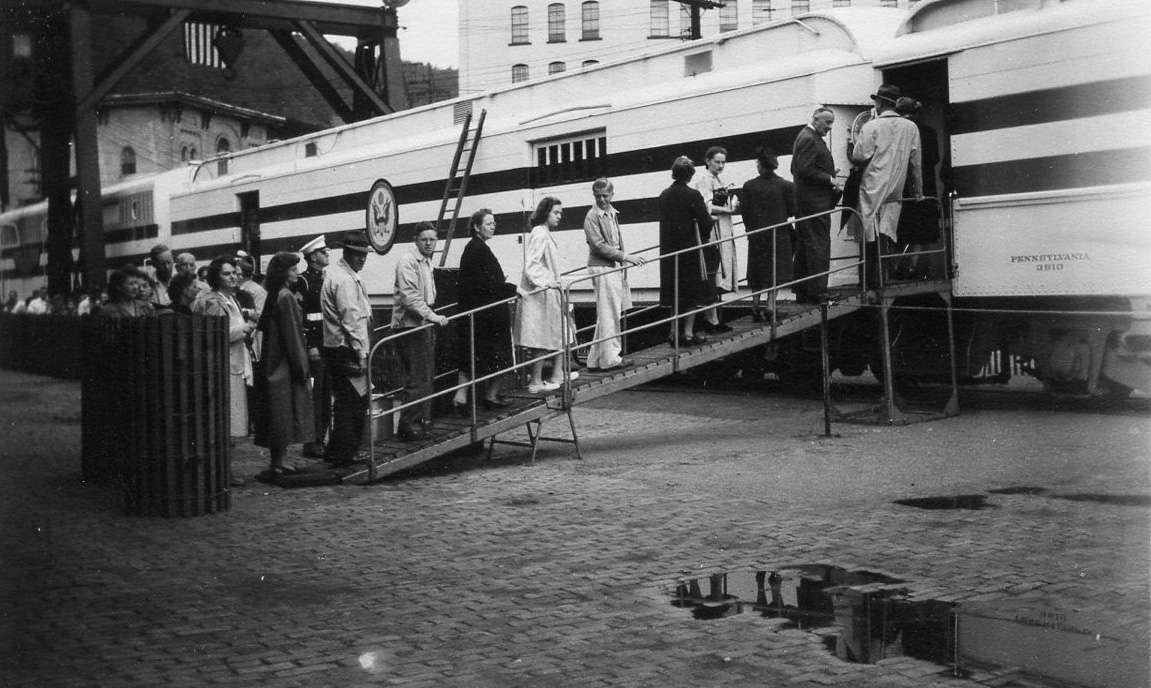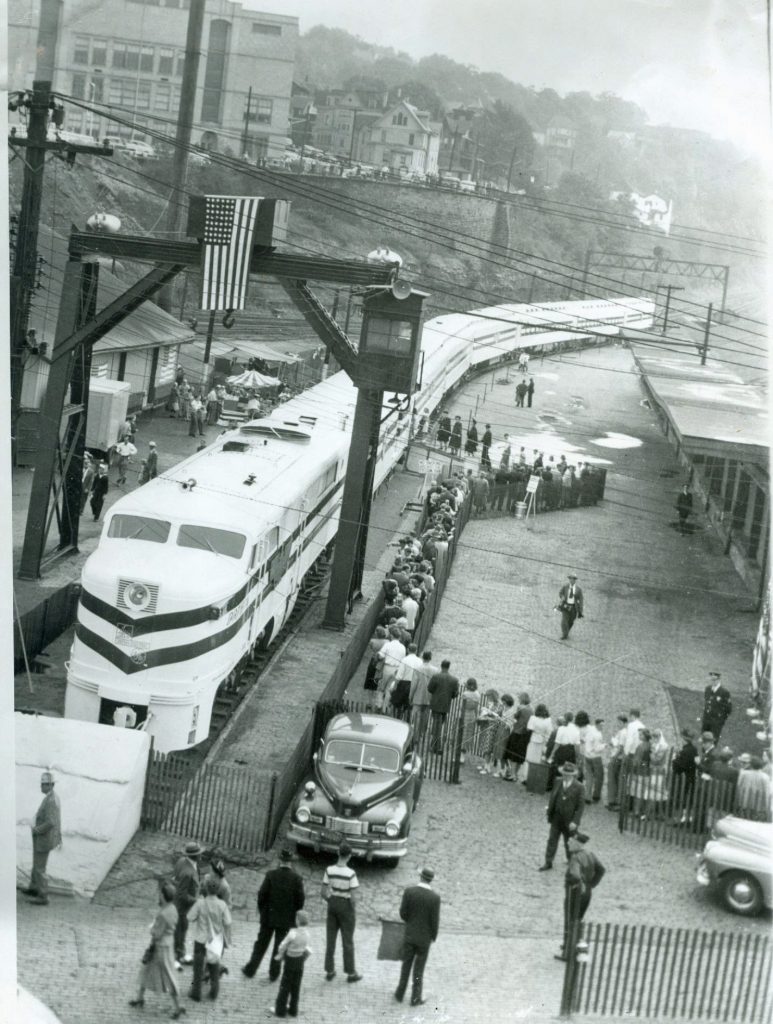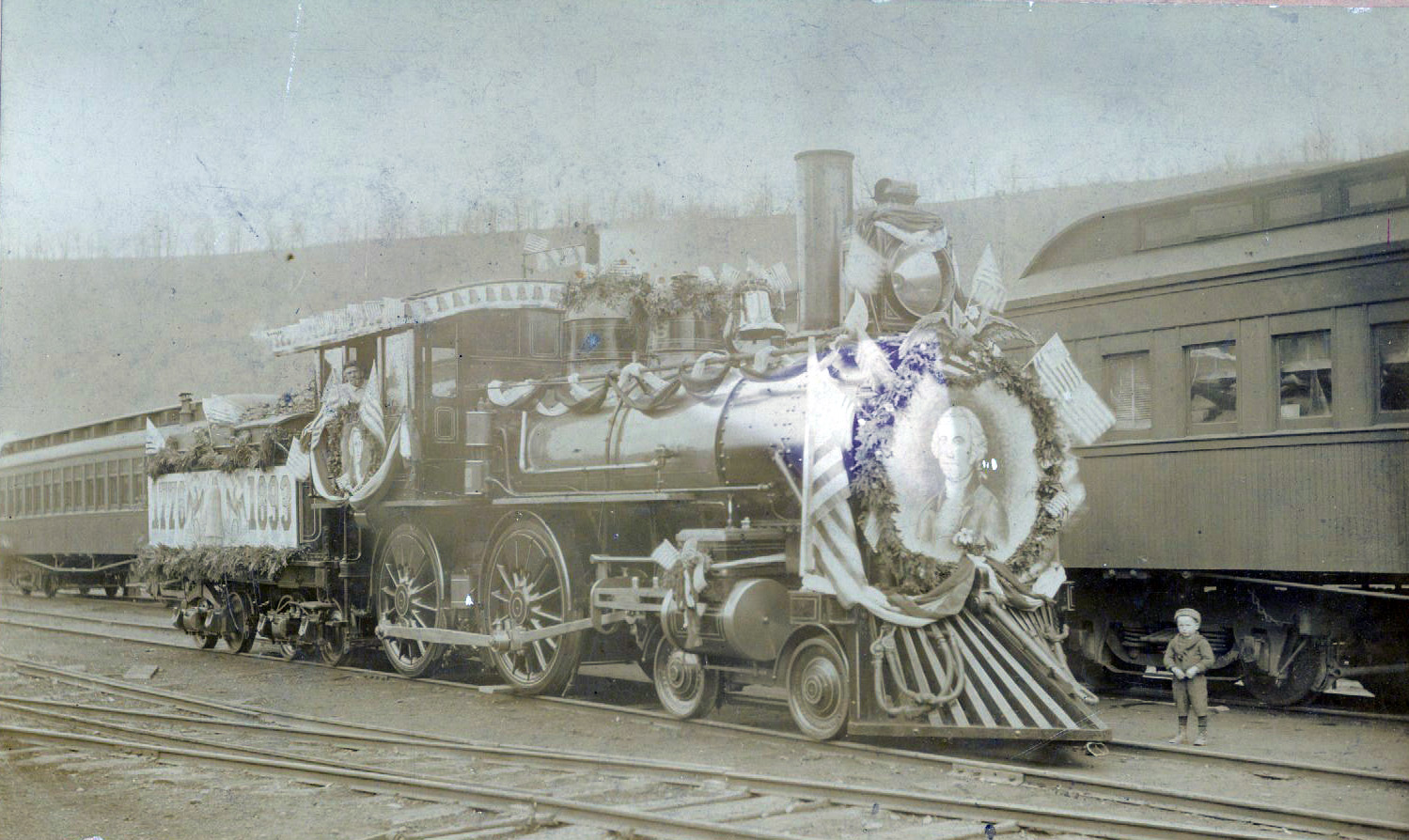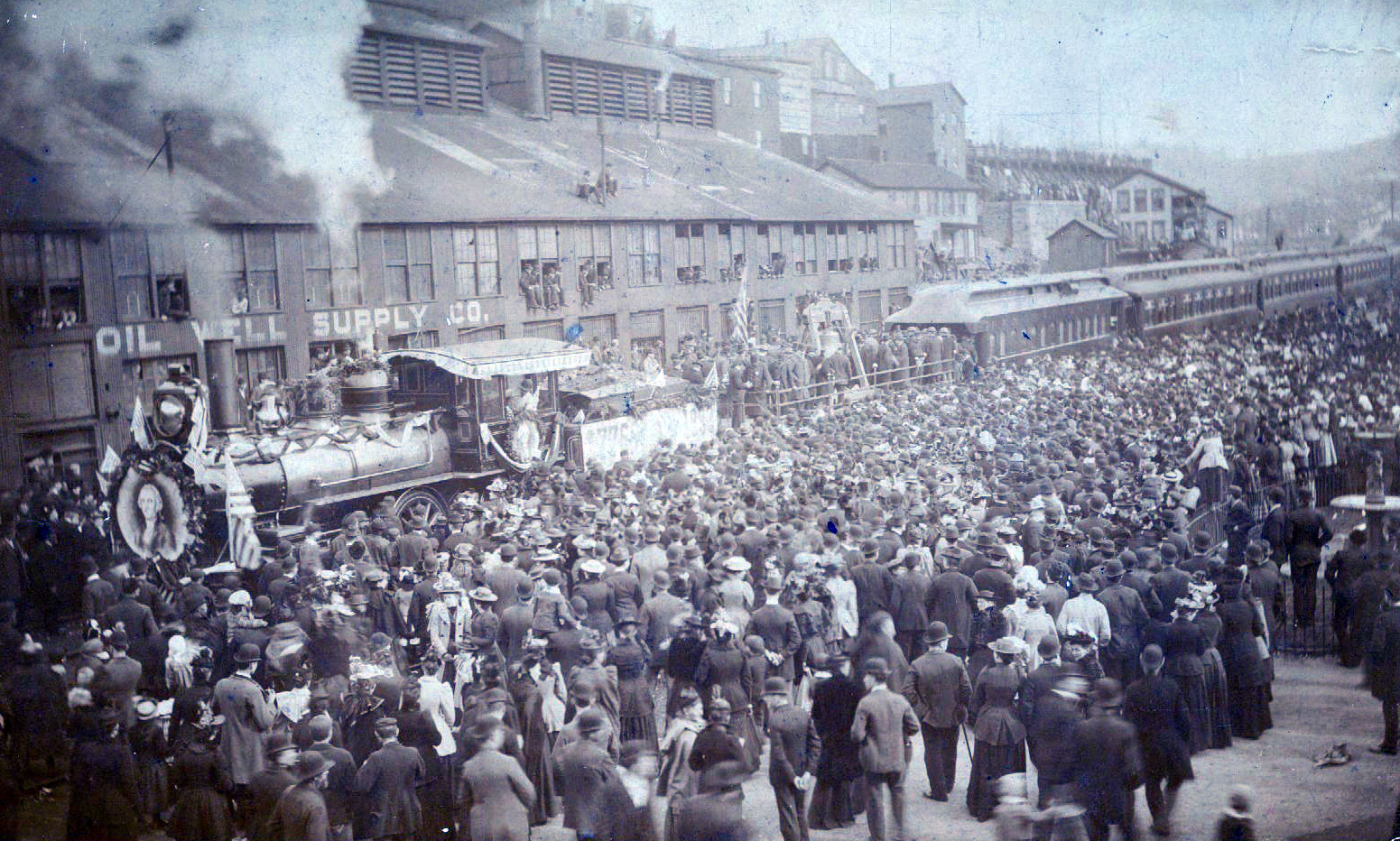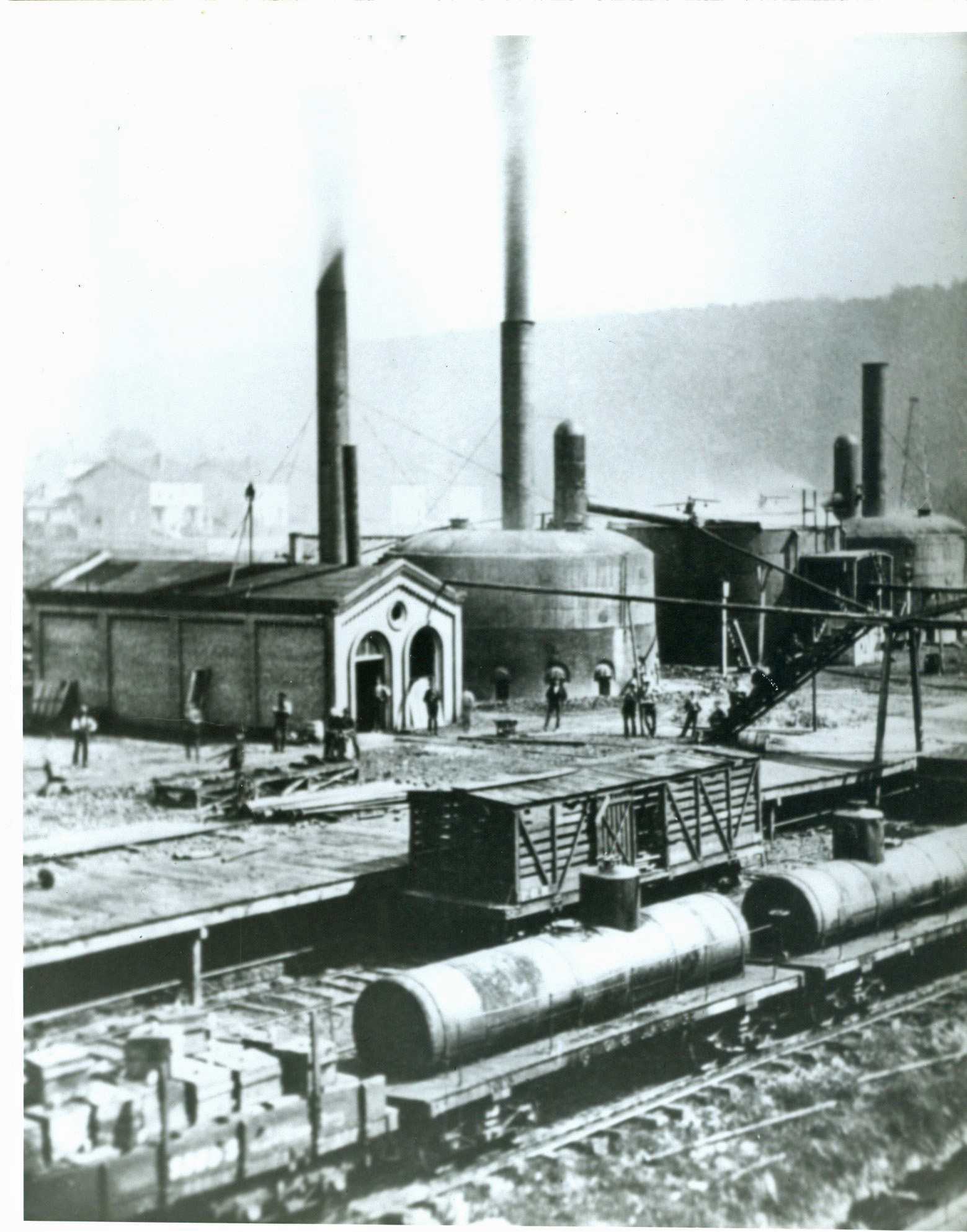Grand Spectacles
- Judy Etzel
- December 3, 2021
- Hidden Heritage
- 3195
Oil City attracted a wide variety of big name athletes, national politicians, actors and actresses, well-known artists, huge circuses and much more as a result of a thriving economy and a philanthropic public.
In its 150-year history, the community has been a destination spot for the famous.
There were unique visitors, too, and they were inanimate – huge cartoon character balloons, the Liberty Bell and a special Freedom Train that contained dozens of the nation’s most important documents.
Towering Balloon Figures
On Nov. 29, 1941, Oil City ushered in the holiday season with an extravagant show: a two-mile long parade featuring more than two dozen inflated cartoon character balloons created by the Goodyear Tire & Rubber Co.
“It will be one of the greatest pre-holiday events ever staged here,” according to a newspaper writer.
“All roads lead to Oil City,” blared the headline for a full page advertisement in The Derrick which encouraged residents and visitors to stay all day, eat, shop and attend the city’s magnificent theaters.
The newspaper estimated the event would draw 50,000 people.
Stories about preparations for the parade, funded by an investment of $35,000 by the Retail Merchants Bureau of the Oil City Chamber of Commerce, filled the pages of the local newspapers. More than 100 local retailers, banks, factories and other businesses would foot the bill.
In a multi-day series of news stories detailing the plans for the parade, the newspaper listed some of the balloon entries, most of which were 60-feet-long and 15-feet high: an orange and green Dracula Dragon that was 80 feet long; 15-foot-high Heap Big Squaw; the largest balloon animal ever created, the prehistoric monster Grubbie Dub Dub. Also in the lineup were Elmer Elephant, Fuzzy Rabbit, Clarabelle the Clown, Mrs. Kangaroo, Drizzle Puss the Bug, Felix the Cat, Donald Duck and a 14-foot-high musical pig. Their value ranged from $400 to $3,000 each.
L.L. Bradford, general chairman for the parade, said it would take more than five hours to inflate the figures and pre-parade duties would take place at the Keystone lot off North Seneca Street.
The procession would begin there at 10 a.m. and travel down Seneca Street, cross the bridge to the South Side and then cross back over and end up back at the Keystone lot.
Bands that marched with the balloon figures, which required 150 local and costumed boys to handle during the parade, were the Oil City High School Drum and Bugle Corps, Oiler Marching Band, VFW Drum and Bugle Corps, Knox Glass Associates Band, Polk State School Band and the American Legion Band.
The parade was led by Bradford, the chairman, who was escorted by local men serving in the armed forces. It would conclude with Santa Claus, who would toss out candy and popcorn balls to children along the way, riding on his own float.
All merchants on the North and South Sides were encouraged to display the American flag. The downtown holiday lights – multi-colored lights strung across the city streets and illuminated silver stars at the intersections – were turned on just prior to the parade.
The parade went off without a hitch and traffic congestion, reported the newspaper the next day, was negligible and “well-handled by our police.” “Following the parade, crowds thronged the stores of the city,” reported the newspaper. “It was one of the largest crowds ever assembled in Oil City and the festive spirit typifies the improvement of conditions throughout the area.”
It was the state of the economy that prompted the city merchants to arrange such an elaborate opening for the Christmas season.
George Fritz, president of the Retail Merchants Bureau, said, “I look for this to be the greatest holiday season in retail selling history.” That was based on employment picking up, he said.
There was good business news in the city. The Pennsylvania Telephone Co. announced it would build a new $550,000 building on Seneca Street.
The newly organized Oil City Tank and Boiler Co. said it intended to hire 75 men for the new mill. The annual YMCA membership drive added 82 new members, taking the total to a record 625 members. A strike had been settled at Manion Steel Barrel with 125 men returning to work. Car dealers were posting record sales. The city’s manufacturing plants were booming.
“With improved economic conditions, increased employment and higher payrolls, merchants are looking forward to a record-breaking Christmas season this year,” editorialized the newspaper.
There was another gala scheduled, too. The following weekend would showcase a major air show at Oil City’s Splane Airport in Oakland Township. About 200 planes were to conduct a mass flight with pilots being from the Oil City Aero Club, the Franklin Aero Club, the Pilots Club and the Women’s Flying Club. A key highlight would be a “defense efficiency contest” for pilots.
The 1941 holiday season would soon be disrupted by a national event – the Dec. 7, 1941, Japanese attack on Pearl Harbor and the advent of World War II. It came one week after the gala holiday opening festivities in Oil City and resulted in a postponement of the air show.
The Freedom Train
Oil City was awash with passenger and freight trains in and out of the city in the late 1800s and up to the early 1960s.
One special train arrived on Sept. 20, 1948, in a national promotion aimed at promoting the embracement and celebration of American citizenship.
The Freedom Train was initiated by President Harry Truman, a fan of trains which he used frequently during his campaign for the presidency. Thomas Clark, the U.S. Attorney General, persuaded Truman to launch an excursion that would send a special train carrying various “documents of liberty” across the country. It would encourage patriotism, said Clark, especially in a new nuclear age and fears of Communist domination in the world.
The multi-car train, painted a bright white with red and blue trim, covered more than 37,000 miles in visits to all 48 states from September 1947 to January 1949. Some 52 different railway companies were tapped, 326 cities visited and 3.5 million people as viewers of the documents. A contingent of uniformed Marines served as honor guards and guides on board the train.
The contents featured more than 100 documents, “treasures that were the earliest inspirations for the American experience,” noted the Freedom Train promotion. The items included the Declaration of Independence, Bill of Rights, Constitution, Emancipation Proclamation, Gettysburg Address, German and Japanese surrender documents, Magna Carta, Iwo Jima flag and much more.
Traveling from Erie, three Freedom Train exhibition cars opened to the public at 9 a.m. at the city’s freight train depot, a site that would later be the location for a Holiday Inn motel. Serving as volunteers were Boy Scouts, National Guardsmen and Legionnaires. A first aid station was provided by the Gray Ladies group.
Newspaper accounts show the first person to enter the exhibition was Oil City Mayor Bill Morck, accompanied by train committee chairman Leo Brewster who was described as the lead advocate for getting the train to Oil City.
By closing time at 10 p.m. nearly 8,500 residents had toured the Freedom Train.
In marking the choice of Oil City as one of the Freedom Train stops, Oil City organizations sponsored several events billed as a Week of Rededication in leading up to its arrival. One event was a concert by the American Legion Band at the Rickards Bandshell on the Central Avenue Plaza and it drew a huge crowd.
There was one controversy during the Freedom Train’s travel across the U.S. City officials in Birmingham, Alabama, declared that “separate but equal times” would be scheduled for whites and blacks to visit the train. It was in keeping with the city’s strict segregation laws.
Freedom Train officials would not accept that, noting it was “an insult to all that the train represented,” and cancelled the visit to Birmingham. No other city subsequently tried to segregate the patrons.
The Liberty Bell
Oil City was one of several western Pennsylvania communities that were included in a visit that featured the original Liberty Bell. Oil City and Titusville were chosen for the visits because of their enormous impact worldwide as the hub of the growing petroleum industry. The city was wealthy and readily accessible by rail and claimed influential residents who lobbied hard to have Oil City included in the brief tour.
The occasion was the Liberty Bell’s journey by train from Philadelphia to the World’s Fair in Chicago.
On April 26, 1893, a train bearing the historic bell stopped at Union Station on the city’s North Side after traveling from Titusville. The decorated WNY&P Engine No. 3, boasting a large round portrait of George Washington on the front, carried a platform car for the bell, three Pullman sleeping cars, a dining car and a car carrying police officers charged with watching over the bell.
Passengers in the Pullman cars included Pennsylvania’s two U.S. Senators, a number of congressmen, Mayor of Philadelphia and other dignitaries.
The newspaper described the bell-carrying train as decked out in patriotic streamers. The platform on which the bell rested was encased in polished steel bars – 13 to denote the original colonies – and another round of bars – 31 to represent the other states in the U.S. American flags surrounded the bell.
Oil City school children were given the day off to go see the Liberty Bell. Local factory workers, too, were given a long lunch hour to visit the train. City factories were instructed that day to blow their steam whistles exactly at 2:30 p.m. as a welcoming salute.
When the train arrived, 13 local children, each carrying a basket of roses, presented them to the dignitaries. They were Jeanette Heively, Regina Moran, Lorraine Beatty, Clara Strance, Margaret Wilber, Genie Rehr, Cora Barber, Charlie Reed, George Darr, Harold Parker, Forrest Weaver, Fred McKinnie and Alfred Ormston.
The officials riding the train made brief remarks and, after cannons were fired on both sides of the river, the train backed up to Siverlyville where the tracks were switched. Returning to Oil City, the train traveled up to Titusville to change engines.
Oil City Mayor Amos Steffee was credited with making “an enormous effort,” noted the newspaper, in enticing the Liberty Bell committee to visit the city. He led a civic committee whose members finalized the details in the city’s Oil Exchange just days before the Liberty Bell train began its Philadelphia to Chicago trip.
A 2002 book entitled “Independence Hall in American Memory” by Charlene Mires, a Villanova University history teacher and former Philadelphia Inquirer editor, refers to the Liberty Bell visit to Oil City.
Mires wrote, “On April 26, 1893, in an oil boomtown 340 miles northwest of Philadelphia, a baby girl was born to Josephine Cooper and her husband William. They named their new daughter in honor of the major event that day in Oil City, Pennsylvania.
“So it was that little Liberty Bell Cooper became a living memorial to the day that the Liberty bell came through Oil City on a train bound for the World’s Columbian Exposition in Chicago.
The author said the anecdote came from the July 25, 1914, edition of “Public Ledger.”
The Liberty Bell returned to Oil City one more time.
On Nov. 24, 1915, a Pennsylvania Railroad train was traveling from Pittsburgh to Buffalo after returning from the Pacific-Panama Exposition in San Francisco. It arranged to have a very brief stop in Oil City.
Despite arriving at Union Depot on the city’s North Side at 3 a.m., a crowd of nearly 3,000 saw the bell. It was set up on a flatbed train car and “brilliantly illuminated,” according to the Blizzard newspaper.
DID YOU KNOW?
In March 1929, newsreels across the country told the story of the largest single shipment of crude oil ever to leave from one spot. And that spot was Oil City.
A Pennzoil train departed from the refinery at Rouseville at 3:40 p.m. March 26 and headed towards Los Angeles. It arrived there at 8:30 a.m. March 30.
The train consisted of 25 tank cars carrying 200,000 gallons. The freight costs were pegged at $19,000.
Written by Judy Etzel with research by Kay Dawson and design by Natalie Cubbon.
HIDDEN HERITAGE IS SPONSORED BY:
YWCA of Oil City
Michael Schneider
Mary Ann & Jim Brown
Support This Project
Donations to the library are appreciated to help offset printing costs & make this project possible! Want to become a sponsor? Email us at promotions@oilregionlibraries.org to get started!
Make a Donation
